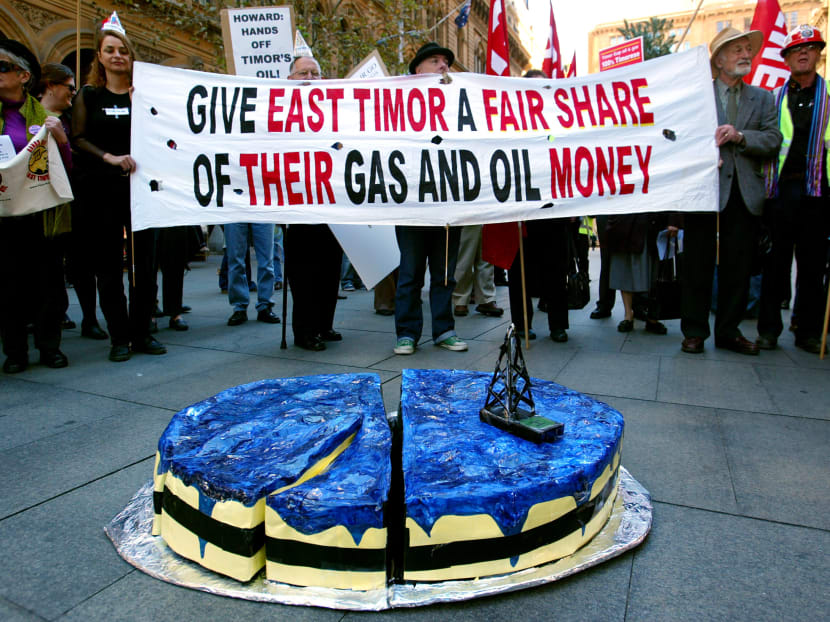Australia’s offshore gas deal could secure improvished East Timor’s future
DILI (EAST TIMOR) — East Timor could earn a maximum 80 per cent revenue from a US$40 billion (S$53.04 billion) offshore gas project in the Timor Sea under a yet-to-be-announced deal with neighbouring Australia, according to media reports.

File picture of protesters holding banners urging the Australian government to strike a fair deal with East Timor amid disputes over gas and oil reserves. Media reports say the Asian nation could earn a maximum 80 per cent revenue from a S$53.04 billion offshore gas project under a yet-to-be-announced deal with Australia. Photo: Reuters
DILI (EAST TIMOR) — East Timor could earn a maximum 80 per cent revenue from a US$40 billion (S$53.04 billion) offshore gas project in the Timor Sea under a yet-to-be-announced deal with neighbouring Australia, according to media reports.
Quoting a source from both countries who is familiar with the ongoing negotiations, Portuguese news agency Lusa said Asia’s youngest country will receive 80 per cent of the revenue if gas from the Greater Sunrise field is piped to an existing processing plant in Darwin, and 70 per cent if it goes to a facility — that has yet to be built — on its southern coastline.
This latest development is expected to generate billions of dollars to the tiny nation that has been struggling to combat poverty and chronic unemployment, at a time when oil revenues are rapidly running dry.
It comes after the two countries reached a breakthrough agreement on sharing revenue arrangements for Greater Sunrise and on a maritime border in September last year, which ended a decade-old row that has stalled the project.
The deal also puts the maritime boundary halfway between the countries, “a huge concession” by Australia, reported The Sydney Morning Herald (SMH).
The existing maritime boundary is aligned with Australia’s continental shelf, but East Timor has long argued the border should lie half way between it and Australia — placing much of the Greater Sunrise fields under its control.
The long-running political dispute has led the owners of the Greater Sunrise fields —Woodside Petroleum, ConocoPhillips, Royal Dutch Shell and Japan’s Osaka Gas — to shelve the project.
The fields are estimated to hold 144 billion cubic meters of gas and 226 million barrels of condensate, which analysts have estimated could be worth US$40 billion.
The “landmark agreement” is expected to be signed in at the United Nations in early March, said SMH.
East Timor and Australia parliaments are expected to ractify the agreement after it is formally signed. Representatives of the two countries are scheduled to finalise the negotiations next Monday (Feb 19) in Malaysia.
Australia’s Department of Foreign Affairs spokesperson said details of the treaty remain confidential, reported SMH.
East Timor’s former President Xanana Gusmao, who is also his country’s chief negotiator for the agreement, has insisted for years Dili would only agree to allow gas to be piped to a plant at the Tasi Mane industrial complex.
Donald Rothwell, Professor of International Law at the Australian National University told SMH that given the rhetoric that has come out of East Timor about the need for permanent maritime boundaries and the economic significance of piping to East Timor, any treaty which does not provide those guarantees may fail to win the political support necessary in Dili for its ratification.
The tiny country is expected to hold elections on May 12, after months of political impasse.
The polls come as concerns mount over the failure to use wealth generated by oil and gas sales to support development and create jobs.
The energy sector accounted for around 60 per cent of GDP in 2014 and more than 90 per cent of government revenue. AGENCIES






